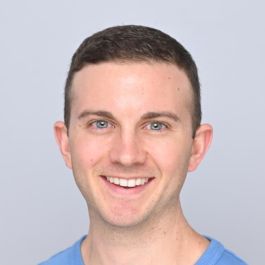There isn’t a “right” way to become a product manager.
Unlike some career fields, product management doesn’t require a specific degree or knowledge base — it’s all about having a unique skill set, often one that’s cultivated across multiple disciplines. From strong communication to strategic thinking, the skills involved in product management make it both an accessible and fulfilling field.
Rachel Leake discovered this firsthand when she broke into product management following a career as a pediatric ICU and oncology nurse. Since stepping into her role as a product manager at Lowe’s, she has found herself leveraging many of the skills that made her successful in the medical field while embracing new ones.
“By openly sharing my nontraditional path into tech, I’ve received positive feedback and proven my ability to adapt and thrive in new environments,” Leake said.
Leaning on a diverse range of skills, product managers can overcome complex challenges throughout the product development process. For Chime Principal Product Manager Josh Aziz, skills such as problem-solving and creativity have helped him spearhead the creation of influential products throughout his career.
Aziz shared that, while there are many skills that define product managers, there are a few that can set top performers apart. That’s why he encourages aspiring product managers to always keep their eyes on the end user — and see their efforts through to the end.
“At your core, be customer-obsessed,” Aziz said. “Pair this with a bias for action — rolling up your sleeves to move things forward.”
Below, Leake, Aziz and two other product managers share how they broke into product management, the skills that have helped them succeed and their advice for those eager to follow in their footsteps.
Lowe’s offers a suite of home improvement products and services for both professionals and consumers.
Can you describe your journey into product management? What motivated you to pursue this career, and what key experiences helped you transition into the role?
I moved into product management after a career as a pediatric ICU and oncology nurse, where I developed strong problem-solving skills and a deep understanding of process flows. Earning my MBA sparked my interest in driving broader impact through innovative solutions, which led me to the tech industry. My unique combination of clinical expertise, teamwork experience and a passion for systems improvement positioned me to successfully transition into product management.
“My unique combination of clinical expertise, teamwork experience and a passion for systems improvement positioned me to successfully transition into product management.”
Tell us about a product you managed from conception to launch. What were the key challenges you faced, and how did you overcome them?
One key feature I helped manage was an effort to onboard a new distribution center node type. The biggest challenge was aligning third-party logistics expectations with internal technical constraints. I overcame this by facilitating workshops with stakeholders, prioritizing user pain points and iterating on solutions to ensure clarity and efficiency with each new site rollout.
What advice would you give to someone looking to follow in your footsteps and become a product manager?
Embrace your unique background — whether it’s clinical, operational or technical — as a strength that sets you apart. Focus on building cross-functional collaboration skills, cultivating a customer-first mindset and taking on roles that challenge you to solve complex problems.
Spring Health’s platform enables employers and health insurers to provide access to mental health care, including meditation, therapy and medication management.
Can you describe your journey into product management? What motivated you to pursue this career, and what key experiences helped you transition into the role?
My journey into product management began in the financial services industry, where I worked as a program manager in software engineering. I’ve always been fascinated by industries that underpin survival, like finance and healthcare.
Early in my career, I encountered critical, complex problems tackled with equally complex and manual solutions. I couldn’t help but think that there has to be a better way. That curiosity and drive to simplify led me to my first product role at Citi, managing mobile check deposit. At the time, capturing a photo of a check and seeing money appear in your account felt both magical and improbable.
That experience revealed the power of technology to transform everyday tasks and cemented my love for product management. I’m driven by a passion to reimagine solutions, simplify complexity and build products that make people’s lives easier and better.
“I’m driven by a passion to reimagine solutions, simplify complexity and build products that make people’s lives easier and better.”
Tell us about a product you managed from conception to launch. What were the key challenges you faced, and how did you overcome them?
One of the products I’m most proud of is Coral Health, designed to reduce avoidable health disparities through personalized recommendations and education. As the first tech hire, I owned product, engineering, analytics, design and program development — starting with a simple sketch on a whiteboard and no full-time engineers or designers.
Our first challenge was validating the product concept quickly. Within two weeks, we launched a webinar-based engagement tool that generated critical insights for our digital experience. From there, I built a clinical rules engine, developed the platform and assembled a team to bring it to life — all within 10 weeks, just in time for the new plan year.
Signing our first pilot deal within months validated our hustle and teamwork. It was an intense, exhilarating experience fueled by collaboration, resilience and the guidance of passionate clinical advisors. This journey taught me the value of speed, iteration and building with purpose.
Wesonga's Advice for Aspiring Product Managers
- Stay curious: “Proactively learn about everything, even what seems unrelated. Great ideas often come from connecting unexpected dots.”
- Master decision-making: “Product management isn’t about chasing what’s ‘cool.’ It’s about blending data, research and intuition to prioritize the right investments.”
- Focus on impact, not flash: “The most meaningful work isn’t always glamorous. Find excitement in solving real problems and improving existing solutions.”
- Develop a holistic skill set: “Success in product requires more than technical expertise. Creativity, influence, adaptability and passion are equally critical.”
- Embrace failure: “Not every idea will succeed. Learn to extract lessons from setbacks and use them to inform your next move.”
Altium’s software tools are designed to support printed circuit board designers, part suppliers and manufacturers, enabling them to develop and manufacture electronics faster and more efficiently.
Can you describe your journey into product management? What motivated you to pursue this career, and what key experiences helped you transition into the role?
I was working as a tech support agent at my first job out of college. I was young and inexperienced, but I was talking to dozens of customers each day. Trial under fire is always the quickest way to learn. I started organizing common customer issues and becoming proficient at describing the “who,” “what” and “why.”
“Trial under fire is always the quickest way to learn.”
The head of product asked me to participate in his department’s weekly meeting to share these insights. Most of the issues found were small, but those are typically the ones that prevent a good product from being great. When it became too much for the product team to handle requests from sales to demonstrate the product to prospective customers, they asked me to step in. I was becoming more and more of an expert on the product and the customers.
A position later opened up to manage a new product helping automotive companies connect to their supply chains. The head of product asked me to join his team. He became my first of many mentors.
Tell us about a product you managed from conception to launch. What were the key challenges you faced, and how did you overcome them?
The first startup I joined manufactured in-vehicle video recording devices designed to help professional fleet managers stay on top of maintenance and driving safety issues. The hardware was barely built when I was hired to help create a telematics application. Videos and vehicle diagnostic data were recorded and later transmitted to the cloud for us to analyze and present in the telematics application.
The backlog of what the fleet manager application needed to do was massive. Many product managers say the toughest part of the job isn’t identifying the things you should do — it’s instead explicitly choosing the things you shouldn’t do and then getting alignment across the organization. This is necessary to give the product team the space and time to succeed.
Luckily for me, we had a great user experience designer. We started working on a set of mockups that focused on driving safety. The story was clear in what we wanted to accomplish. It also showed we would not work on vehicle diagnostics or location services for the first release. The focus helped remove distractions and enabled us to launch the application in two months.
What advice would you give to someone looking to follow in your footsteps and become a product manager?
There are many paths to product management. I started in tech support, but my colleagues over the years have mostly come from sales, marketing and engineering.
When I started as a software product manager in the late 1990s, the concept was relatively new. The most common training was through the Pragmatic Institute, where you learned how to create personas, user stories and a prioritized backlog. This was good at the time and enabled product managers to be the glue that keeps engineering, sales, marketing and executive teams aligned.
Nowadays, most product managers in my network follow the teachings of Marty Cagan’s Silicon Valley Product Group. I’ve had formal training, but you don’t necessarily need it. You can start by reading Cagan’s book, Inspired: How to Create Tech Products Customers Love.
Chime’s mobile banking app and financial solutions help consumers build their credit history and improve their financial literacy.
Can you describe your journey into product management? What motivated you to pursue this career, and what key experiences helped you transition into the role?
My journey into product management started with a curiosity to understand not just how things work but why they matter. At the University of Waterloo, I was part of a co-op program that alternated between school and full-time roles across different industries. As a software engineer in one of my co-ops, I was often solving problems without understanding the bigger picture. That gap frustrated me, but it also lit a spark; I wanted to connect the technical “how” with the strategic “why.”
When I discovered product management during a later co-op placement, everything clicked. It combined my technical background with my passion for problem-solving, being curious and taking a creative approach. I loved empowering engineers and others on our teams to make a bigger impact. These skills, along with my drive to ask the right questions and be quick to adapt, have shaped my career and continue to fuel my work today at Chime, where we help unite everyday people to unlock their financial progress.
Tell us about a product you managed from conception to launch. What were the key challenges you faced, and how did you overcome them?
One of my proudest achievements this year was launching MyPay, a product that gives Chime members early access to up to $500 of their pay[1] — without the usual fees, interest[2] or credit checks. The journey from concept to launch was filled with challenges, particularly navigating the many unknowns of how to bring such an ambitious vision to life.
A key hurdle was aligning our large cross-functional group around a shared definition of success, especially as new complexities came up. To address this, I zoomed out to articulate a clear vision, showing team members how their work connected to the bigger picture, and zoomed in to remove roadblocks as they arose. Balancing high-level strategic thinking with a hands-on approach to problem-solving was critical.
By fostering alignment, driving creative solutions and focusing relentlessly on member impact, we successfully launched MyPay. It’s a product that continues to grow, helping members bridge the gap between paydays and make meaningful financial progress.
What advice would you give to someone looking to follow in your footsteps and become a product manager?
There’s no “perfect background” for becoming a product manager — what matters most is your mindset and the ability to hone key product skills. Some of the best product managers I’ve worked with have come from diverse paths: customer support, engineering, founding startups and even non-tech fields. The common thread is the mindset and skills they bring to the role, which anyone can develop with focus and practice.
“There’s no ‘perfect background’ for becoming a product manager — what matters most is your mindset and the ability to hone key product skills.”
Develop structured thinking to prioritize ruthlessly and practice being creative to solve ambiguous problems. Master clear and frequent written communication, use data to guide decisions without over-relying on intuition and build technical depth to understand the systems behind the products you shape.
These skills apply far beyond product management — they’re valuable in tech, school and your passion projects. Take an honest inventory of your strengths and identify one skill to sharpen next. Like any good product manager, you can’t make everything priority number one, but with deliberate focus, you’ll get closer to your goal
1. Eligibility requirements apply. Not all users will qualify. Credit limits range from $20-$500.
2. Option to get funds instantly for $2 per advance or get funds for free within 24 hours.













